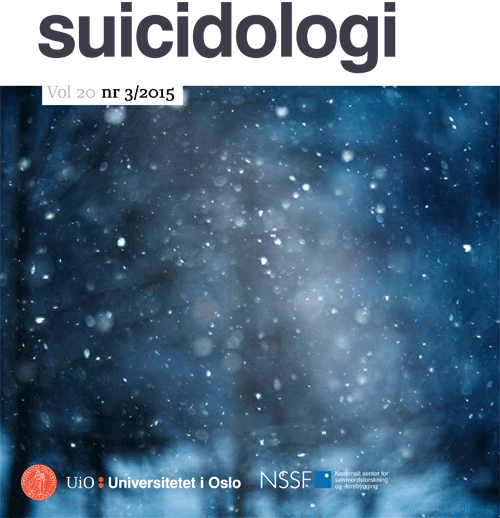Det trengs mange og handlekraftige (første)hjelpere!
DOI:
https://doi.org/10.5617/suicidologi.2630Resumé
SAMMENDRAG
Verdens Helseorganisasjon og norske myndigheter har satt som mål
at selvmordsforsøk og selvmord skal reduseres. Dette kan oppnås
via forskjellige former for opplæring. Kunnskap om selvmordsforebygging
må derfor formidles til store befolkningsgrupper. I Norge
har Vivat Selvmordsforebygging en viktig rolle i dette undervisningsarbeidet.
Kurset «Førstehjelp ved selvmordsfare» er nylig revidert i
tråd med tilgjengelig kunnskap. De bærende elementer i kurset er
beholdt, men viktig ny forståelse er lagt til. Hjelperens vilje og evne
til å ta ledelse i førstehjelpsinnsatsen er tydeliggjort. Et annet og
sentralt element er brakt inn; sammen med personen i fare leter man
etter hva som kan utgjøre vendepunktet bort fra selvmord og mot
fortsatt liv. Både nasjonale og internasjonale studier tyder på at deltakerne
på kurset opplever at de er bedre i stand til å yte nødvendig
førstehjelp etter gjennomført opplæring.
ABSTRACT
The World Health Organization and Norwegian authorities have set
as a target that the numbers of suicide attempts and completed suicides
should be reduced. This can be achieved by the use of various
forms of training. Knowledge about suicide prevention must therefore
be communicated to large groups of people. Vivat Selvmordforebygging
plays an important role in this educational effort. The workshop
“Førstehjelp ved selvmordsfare” (ASIST) has recently been revised
in line with current knowledge. The fundamental elements of the
workshop are retained, and important new understanding has been
added. The helper’s willingness and ability to conduct guidance in
first aid is underlined. Another central element is brought in; together
with the person at risk, we look for what might constitute a turning
point away from completed suicide and towards continued life. Both
national and international studies suggest that participants at these
workshops find that their skills in providing appropriate first aid have
improved significantly after completing training.
Referencer
REFERANSER
Ashwood, J., Briscombe, B., Ramchand, R., May, E. & Burnam, M. (2015). Analysis of the Benefits and Costs of CalMHSA’s Investment in Applied Suicide Intervention Skills Training (ASIST). Hentet 24.06.2015 fra http://www.rand.org/pubs/research_
reports/RR1115.
Everall, R. D., Bostik, K. E. & Paulson, B. L. (2006). Being in the Safety Zone: Emotional Experiences of Suicidal Adolescents and Emerging Adults. Journal of Adolescent Research, 21(4), 370-392. doi:10.1177/0743558406289753
Gould, M. S., Cross, W., Pisani, A. R., Munfakh, J. L. & Kleinman, M. (2013). Impact of Applied Suicide Intervention Skills Training on the National Suicide Prevention Lifeline. Suicide and Life-Threatening Behavior, 43(6), 676-691. doi:10.1111/sltb.12049
Helsedirektoratet. (2014). Handlingsplan for forebygging av selvmord og selvskading. Oslo. Hentet fra https://helsedirektoratet.no/Lists/Publikasjoner/
Attachments/117/Handlingsplan-for-forebygging-av-selvmord-og-selvskading- 2014-2017-IS-2182.pdf
Isaac, M., Elias, B., Katz, L. Y., Belik, S.-L., Deane, F. P., Enns, M. W. & Sareen, J. (2009). Gatekeeper training as a preventative intervention for suicide: a systematic review. Canadian Journal of Psychiatry-Revue Canadienne de Psychiatrie 54 (4), 8.
Jobes, D. A. (2006). Managing suicidal risk : a collaborative approach. New York: Guilford Press.
Kogstad, R. E., Ekeland, T. J. & Hummelvoll, J. K. (2011). In defence of a humanistic approach to mental health care: recovery processes investigated with the help of clients’ narratives on turning points and processes of gradual change. J Psychiatr Ment Health Nurs, 18(6), 479-486. doi:10.1111/j.1365 2850.2011.01695.x
LivingWorks. (2010). Applied Suicide Intervention Skills Training. Trainee Experiences, Recommendations, and Post-Training Behavior. Hentet fra https://www. livingworks.net/dmsdocument/273
LivingWorks. (2013). ASIST Applied Suicide Intervention Skills Training. Evidence in Support of the ASIST 11 Program. Hentet 23.06. fra file:///C:/Users/dwtall/Downloads/
Evidence-in-Support-of-the-ASIST-11-Program%20(1).pdf
Mann, J. J., Apter, A., Bertolote, J., Beautrais, A., Currier, D., Haas, A., . . . Hendin, H.
(2005). Suicide prevention strategies: a systematic review. JAMA, 294(16), 2064- 2074. doi:10.1001/jama.294.16.2064
McConnell, A. & Drennan, L. (2006). Mission Impossible? Planning and Preparing for Crisis1. Journal of Contingencies and Crisis Management, 14(2), 59-70. doi:10.1111/j.1468-5973.2006.00482.x
Rasmussen, M. L., Haavind, H., Dieserud, G. & Dyregrov, K. (2013). Exploring Vulnerability to Suicide in the Developmental History of Young Men: A Psychological Autopsy Study. Death Studies, 38(9), 549-556. doi:10.1080/07481187.2013.780113
Tallaksen, D. W. (2014). Ved livets farlige ytterpunkter. I S. Tveiten, & K. Boge (Red.), Empowerment i Helse, ledelse og pedagogikk – nye perspektiver. Oslo: Gyldendal Akademisk.
Tallaksen, D. W., Bråten, K. & Tveiten, S. (2013). “… You are not particularly helpful as a helper when you are helpless” A qualitative study of P ublic Health Nurses and their professional competence related to suicidal adolescents. Vård i Norden.
Nordic Journal of Nursing Research, 33(1), 46-50.
WHO. (2014). Preventing Suicide. A global imperative. Geneva. Hentet fra http://apps.who.int/iris/bitstream/10665/131056/1/9789241564779_eng.pdf
Williams, M. (2001). Suicide and attempted suicide. London: Penguin Books
Downloads
Nummer
Sektion
Licens
Dette tidsskriftet gir umiddelbar og fri tilgang (Open Access) til tidsskriftets innhold, ut fra det prinsipp at det å gjøre forskning fritt tilgjengelig for allmennheten gir økt global utveksling av kunnskap.
Forfattere som publiserer i dette tidsskriftet aksepterer følgende vilkår:
1. Forfatter beholder opphavsrett til sine verk i henhold til Åndsverkloven, og gir Suicidologi rett til første publisering av et verk.
2. Forfatter kan inngå separate tilleggsavtaler om ikke-eksklusiv distribusjon av den publiserte utgaven av sine artikler (f.eks. levere den inn til et institusjonelt publiseringsarkiv) så lenge Suicidologi blir kreditert som første utgiver.
3. Leseres bruk av tidsskriftet må skje i tråd med Åndsverkloven.


